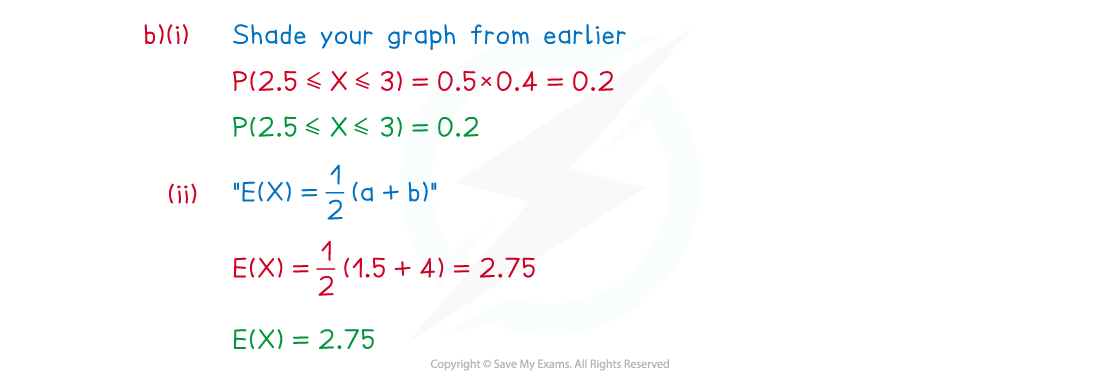Continuous Uniform Distribution
What is meant by the continuous uniform distribution?
- This is a special case of a probability density function for a continuous random variable
- The normal distribution is another special case covered in S1
- The uniform, or rectangular, distribution is a p.d.f. that is constant and non-zero over a range of values but zero everywhere else

- Since the area under the graph has to total 1, the height of the uniform distribution would be
- Therefore the probability density function is given by
How do I find probabilities for a continuous uniform distribution?
- Sketch the graph of y= f(x)
- Probabilities are the area under the graph, all such areas will now be rectangles
- Finding the area of a rectangle is likely to be easier than integration!
- The symmetrical properties of rectangles may also be used to find probabilities
How do I find the mean, median, mode and variance of a continuous uniform distribution?
- The mean, or expected value, is given by
- This is the (vertical) axis of symmetry of the rectangle
- Should the above be forgotten,
can still be applied
- You be may asked to use this to prove the result
- The median can also be found by symmetry and will be equal to the mean
- There is no mode as f(x) is equal - and so at its greatest - for all values of x
- The variance is given by
- Should the above be forgotten,
or
can still be applied
- You may be asked to use this to prove the result
- The standard deviation is the square root of the variance
Worked example
A continuous random variable, , is modelled by the uniform distribution such that
for
and
otherwise.
a is a constant.
(a)
Show that the value of a is 1.5 .
(b)
Find
(i)
(ii)
(c)
Find the standard deviation of X, giving your answer in the form %22%2F%3E%3Cpolyline%20fill%3D%22none%22%20points%3D%226%2C0%202%2C-7%201%2C-6%22%20stroke%3D%22%23000000%22%20stroke-linecap%3D%22square%22%20stroke-width%3D%221%22%20transform%3D%22translate(9.5%2C23.5)%22%2F%3E%3Cline%20stroke%3D%22%23000000%22%20stroke-linecap%3D%22square%22%20stroke-width%3D%221%22%20x1%3D%2223.5%22%20x2%3D%2235.5%22%20y1%3D%224.5%22%20y2%3D%224.5%22%2F%3E%3Ctext%20font-family%3D%22Times%20New%20Roman%22%20font-size%3D%2218%22%20text-anchor%3D%22middle%22%20x%3D%2229.5%22%20y%3D%2220%22%3E3%3C%2Ftext%3E%3C%2Fsvg%3E) , where a is a rational number.
, where a is a rational number.
(a)
Show that the value of a is 1.5 .

(b)
Find
(i)
(ii)

(c)
Find the standard deviation of X, giving your answer in the form %22%2F%3E%3Cpolyline%20fill%3D%22none%22%20points%3D%226%2C0%202%2C-7%201%2C-6%22%20stroke%3D%22%23000000%22%20stroke-linecap%3D%22square%22%20stroke-width%3D%221%22%20transform%3D%22translate(9.5%2C23.5)%22%2F%3E%3Cline%20stroke%3D%22%23000000%22%20stroke-linecap%3D%22square%22%20stroke-width%3D%221%22%20x1%3D%2223.5%22%20x2%3D%2235.5%22%20y1%3D%224.5%22%20y2%3D%224.5%22%2F%3E%3Ctext%20font-family%3D%22Times%20New%20Roman%22%20font-size%3D%2218%22%20text-anchor%3D%22middle%22%20x%3D%2229.5%22%20y%3D%2220%22%3E3%3C%2Ftext%3E%3C%2Fsvg%3E) , where a is a rational number.
, where a is a rational number.

Exam Tip
- A sketch of the graph of a uniform distribution is quick and will highlight the symmetry in a uniform distribution
- Use areas of rectangles to find probabilities rather than integrating

